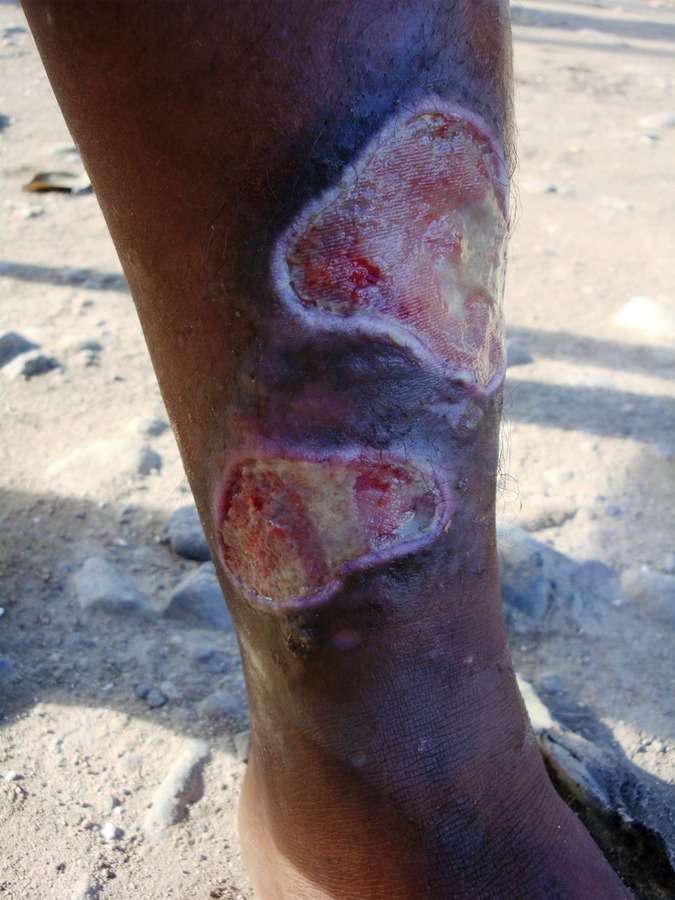Buruli ulcer disease, caused by infection with Mycobacterium ulcerans, is prevalent in central and western Sub-Saharan Africa and in southeastern Australia, and it occurs sporadically in other tropical and subtropical locales [1–3]. This report addresses a case of possible Buruli ulcer disease in an adolescent girl in Honduras. The subject was a 16-year-old female living in a rural coastal village in Honduras (near La Ceiba). She developed 2 ulcerative lesions on her leg that grew from small pinpoint lesions, to abscesses, to large undermined ulcers over a period of several weeks (see Figure 1). The lesions were painless. Local topical remedies were ineffective. She had no systemic symptoms, and she did not develop other lesions. There was no history of trauma. Insect and mosquito bites are a part of everyday life in her village, and she had not traveled elsewhere. There were no contacts with similar lesions. She was discovered during a medical mission trip to Honduras. Scrapings and small biopsies were performed and transported in sealed, insulated sterile tubes (with a minuscule amount of sterile saline) for processing in the United States. Treatment with topical antifungals and oral itraconazole was of no benefit. She was later treated with oral rifampin and clarithromycin [4, 5]. When other members of the mission team returned to the area several months later, the young woman could not be found. After return to the United States, the scrapings and biopsies were processed in the clinical microbiology laboratory of Parkland Health and Hospital System in Dallas, Texas. They were cultured in the MGIT (Becton-Dickenson) system as well as on Lowenstein-Jensen medium. Both scrapings and tissue biopsies were stained with acid-fast stains. The stains revealed clumps of acid-fast bacilli, both intra- and extracellular in location. Cultures performed at 30°C, and held for 8 weeks, grew scantily and were presumptively identified as M ulcerans by phenotypic methods. There was growth at 30°C, but not at higher temperatures, nor at 25°C. Small colonies showed rough morphology on Lowenstein-Jensen medium, they were nonpigmented, and niacin and nitrate reduction tests were negative [6]. AccuProbes for Mycobacterium tuberculosis, Mycobacterium avium, Mycobacterium gordonae, and Mycobacterium kansasii complexes were negative. Funding limitations precluded molecular characterization. We believe that this represents a case of Buruli ulcer disease acquired in coastal Honduras. No reports of this condition in Honduras were found in the PubMed, MeSH, or Cochrane Reviews databases [7, 8]. Thus, this is the first known report of Buruli ulcer disease acquired in Honduras.
Figure 1.

Acknowledgments
Potential conflicts of interest. All authors: No reported conflicts. All authors have submitted the ICMJE Form for Disclosure of Potential Conflicts of Interest.
References
- 1.Merritt RW, Walker ED, Small PL et al. . Ecology and transmission of Buruli ulcer disease: a systematic review. PLoS Negl Trop Dis 2010; 4:e911.Doi:10.1371/journal.pntd.0000911. [DOI] [PMC free article] [PubMed] [Google Scholar]
- 2.Huang GK, Johnson PD. Epidemiology and management of Buruli ulcer. Expert Rev Anti Infect Ther 2014; 12:855–65. [DOI] [PubMed] [Google Scholar]
- 3.Johnson PD, Hayman JA, Quek TY et al. . Consensus reommendations for the diagnosis, treatment and control of Mycobacerium ulcerans infection (Bairnsdale or Buruli ulcer) in Victoria, Australia. Med J Aust 2007; 186:64–8. [DOI] [PubMed] [Google Scholar]
- 4.Chauty A, Ardant M-F, Marsollier L et al. . Oral treatment for Mycobacerium ulcerans infection: results from a pilot study in Benin. Clin Infect Dis 2011; 52:94–6. [DOI] [PubMed] [Google Scholar]
- 5.Alffenaar JWC, Nienhuis WA, de Velde F et al. . Pharmacokinetics of rifampin and clarithromycin in patients treated for Mycobacterium ulcerans infection. Antimicrob Agents Chemother 2010; 54:3878–83. [DOI] [PMC free article] [PubMed] [Google Scholar]
- 6.Richter E, Brown-Elliott BA, Wallace RJ Jr. Mycobacterium: laboratory characteristics of slowly growing mycobacteria. In: Versalovich J, Carroll KC, Jorgensen JH, Funke G, Landry ML, Warnock DW, eds. Manual of Clinical Microbiology. 10th ed. Vol 1 Washington, DC: ASM Press, 2011:503–524. [Google Scholar]
- 7.Ault SK. The Pan American Health Organization's role and perspectives on the mapping and modeling of the neglected tropical diseases in Latin America and the Caribbean: an overview. Mem Inst Oswaldo Cruz 2007; 102(suppl 1):99–107. [DOI] [PubMed] [Google Scholar]
- 8.Ault SK, Nicholls RS, Saboya MI. The Pan American Health Organization's role and perspectives on the mapping and modeling of the neglected tropical diseases in Latin America and the Caribbean: an overview. Geospat Health 2012; 6:57–9. [DOI] [PubMed] [Google Scholar]


